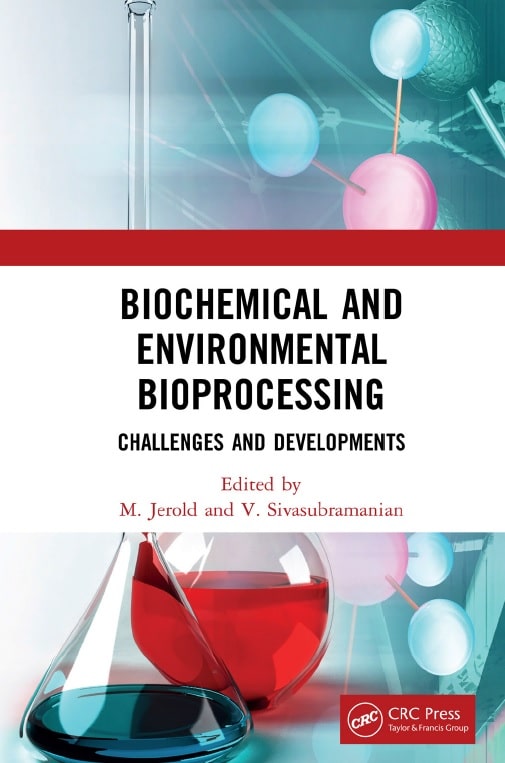
Contents
Foreword………………………………………………………………………..vii
Preface……………………………………………………………………………ix
Editors……………………………………………………………………………………xi
Contributors……………………………………………………………. xiii
Chapter 1 Biosorption – An Elective Strategy for Wastewater Treatment:
An Eco-Friendly Approach………………………………………………………….1
A. Saravanan, P. Senthil Kumar and P. R. Yaashikaa
Chapter 2 Recent Advancements and Perspectives on Biological
Degradation of Azo Dye…………………………………………………………… 17
Rajmohan K. S., Ramya C. and Murali Mohan Seepana
Chapter 3 Performance Analysis of Anaerobic Digestion of Textile Dyeing
Industry Effluent in a Modified Sequential Batch Reactor…………….. 37
S. Venkatesh Babu and M. Rajasimman
Chapter 4 Waste Sea Shells for Biodiesel Production – Current Status
and Future Perspective……………………………………………………………… 53
Subramaniapillai Niju and M. Balajii
Chapter 5 An Intensified and Integrated Biorefinery Approach for
Biofuel Production…………………………………………………………………….87
Devadasu Sushmitha and Srinath Suranani
Chapter 6 Hydrothermal Carbonization for Valorization of Rice Husk ……….. 105
B. Sai Rohith, Naga Prapurna, Kuldeep B. Kamble,
Rajmohan K. S. and S. Srinath
Chapter 7 Production of Biofuels from Algal Biomass………………………………. 123
Murali Mohan Seepana, M. Jerold and Rajmohan K. S.
Chapter 8 Diffusion Limitations in Biocatalytic Reactions:
Challenges and Solutions………………………………………………………… 139
Carlin Geor Malar, Muthulingam Seenuvasan and Kannaiyan
Sathish Kumar
Chapter 9 Recent Advancements and Applications of Nanotechnology in
Expelling Heavy Metal Contaminants from Wastewater…………….. 151
Muthulingam Seenuvasan, Venkatachalam Vinothini, Madhava
Anil Kumar and Ayyanar Sowmiya
Chapter 10 Organic Flocculation as an Alternative for
Wastewater Treatment…………………………………………………………….. 163
Devlina Das
Chapter 11 Power Production in Microbial Fuel Cells (MFC):
Recent Progress and Future Scope……………………………………………. 179
E. Elakkiya and Subramaniapillai Niju
Chapter 12 Synthesis, Characterization and Antimicrobial Properties of
CuO-Loaded Hydrophobically Modified Chitosans…………………….203
P. Uma Maheswari, K. Sriram and K. M. Meera Sheriffa Begum
Chapter 13 Fucoxanthin: Biosynthesis, Structure, Extraction,
Characteristics, and Its Application………………………………………….. 221
K. Anjana and K. Arunkumar
Index……………………………………………. 251
Preface
An emerging field in applied science, bioprocess engineering is the amalgamation of science and engineering. Basically, the life science aspects are translated into applied products for the commercialization process. Today, bioprocessing has become an essential part of various industries such as food, chemical, pharmaceutical and environmental industries. In microbial bioprocessing, plant and animal cells are used as a major component for the production of biological products. In environmental components, the toxic products are neutralized by means of microbial bioprocessing.
In microbial bioprocessing, enzymes play an important role in the bioconversion of substrate into products. Microorganisms are key players which can be either aerobic or anaerobic. In some cases, they can be facultative organisms. The reliability of the bioprocess depends upon the usage of either wild type or recombinant type strains. In the present scenario, the environment is disturbed by various xenobiotic compounds. Industries especially discharge various toxic and other byproducts into the atmosphere. Such pollutants are accumulating and cause environmental problems.
Biotechnology has a wide scope in degradation and bioconversion. In order to make the process into a realistic approach, there is a need for large-scale bioreactors. Hence, the integration of bioprocessing and biochemical engineering surely can be a prospect for the successful implementation of life science fundamental research. This book, Biochemical and Environmental Bioprocessing: Challenges and Developments, is the work of eminent researchers and academicians in the field of biotechnology and chemical engineering. This book was initiated with a vision to project the importance of biochemical engineering for sustainable pollution management.
Green technology has a significant role in the development of eco-friendly bio-products. Essentially, there is a great demand for the production in terms of energy efficiency and cost effectiveness. Therefore, there is continuous research in the bioprocess to make the process simpler to cut down the cost. This book contains 13 chapters related to wastewater treatment, bioenergy production, synthesis of nanoparticles, microbial fuel cells, biopolymer, algal biomass, kinetics, modeling and so on. This book is a consolidated research output by various interdisciplinary researchers. Hence, one can easily correlate the fundamentals and applied knowledge for the valorization of waste into value-added bio-products. Basically, environmental sustainability is to reduce the impact on the environment by the concepts: reduce, reuse and recycle. However, due to the population explosion and industrial expansion, it is very difficult to safeguard the environment. Thus, it is highly essential to implement bioremediation to avoid contamination. In addition, the waste has to be used as feedstock for the conversion into useful products. Hopefully, this book will address the problems pertaining to the environmental issues by innovative and advanced bioprocess techniques. This book is meticulously organized to give comprehensive ideas to solve the challenging environmental issues by benign green technologies.
Moreover, this book can be used by students, researchers, academicians and engineers who are working in any area of research. The multidimensional perspective of this book will enable readers to explore a wide range of recent trends in bioremediation.
1 Biosorption – An Elective Strategy for Wastewater Treatment An Eco-Friendly Approach
A. Saravanan, P. Senthil Kumar and P. R. Yaashikaa
CONTENTS
1.2 Water Pollutants…………………………………………………………………2
1.2.1 Heavy Metals and Their Toxicity………………………………………………….2
1.3 Conventional Methodologies…………………………………………………………………..3
1.3.1 Coagulation and Flocculation……………………………………………………….4
1.3.2 Ion Exchange……………………………………………………………………………..4
1.3.3 Precipitation……………………………………………………………………………….5
1.3.4 Membrane Filtration……………………………………………………………………5
1.3.5 Electrochemical Processes…………………………………………………………..5
1.4 Biosorption Process……………………………………………………………………………….6
1.5 Biosorption Mechanism………………………………………………………………………….7
1.5.1 Bacteria……………………………………………………………………………………..8
1.5.2 Fungi…………………………………………………………………………………………8
1.5.3 Algae…………………………………………………………………………………………8
1.6 Factors Affecting the Biosorption Process………………………………………………..9
1.6.1 pH…………………………………………………………………………………………….9
1.6.2 Temperature……………………………………………………………………………….9
1.6.3 Characteristics and Concentration of Biomass……………………………… 10
1.6.4 Initial Metal Ion Concentration………………………………………………….. 10
1.7 Biosorbents………………………………………………………………………………………… 10
1.7.1 Techniques for Biosorbent Characterization………………………………… 11
1.8 Biosorption Isotherms………………………………………………………………………….. 12
1.8.1 Langmuir Isotherm…………………………………………………………………… 12
1.8.2 Freundlich Isotherm………………………………………………………………….. 13
1.8.3 Constraint of Freundlich Adsorption Isotherm…………………………….. 13
1.9 Kinetics Study…………………………………………………………………………………….. 13
1.10 Conclusion…………………………………………………………………………………………. 14
References…………………………………………………………………… 15
